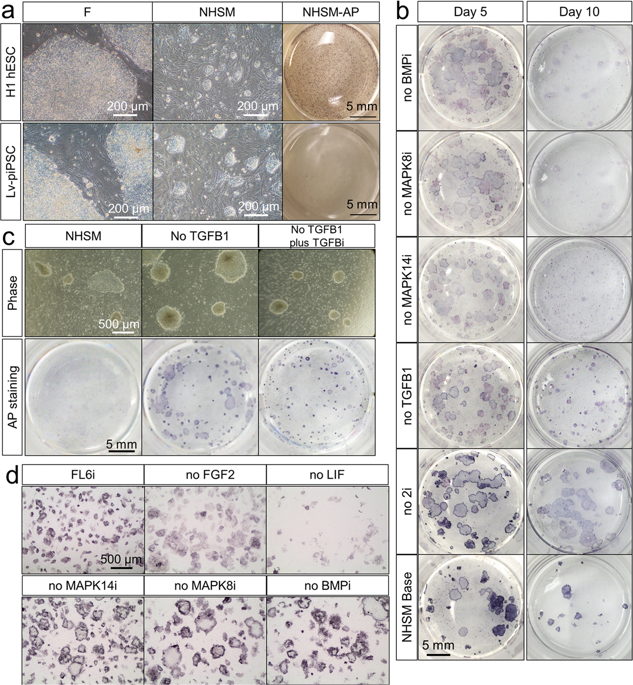Cell Death Discovery ( IF 6.1 ) Pub Date : 2019-06-17 , DOI: 10.1038/s41420-019-0184-4 Ye Yuan , Jinkyu Park , Yuchen Tian , Jungmin Choi , Rolando Pasquariello , Andrei P. Alexenko , Aihua Dai , Susanta K. Behura , R. Michael Roberts , Toshihiko Ezashi

|
Understanding essential signaling network requirements and making appropriate adjustments in culture conditions are crucial if porcine pluripotent stem cells (PSC) are to achieve their full potential. Here, we first used two protein factors (LIF and FGF2) and kinase inhibitor combinations in attempts to convert primed type lentiviral-reprogrammed porcine induced PSC (Lv-piPSC) into naïve-like state and developed a medium called FL6i. In addition to FGF2 and LIF, this medium contained inhibitors of MAPK14, MAPK8, TGFB1, MAP2K1, GSK3A and BMP. Crucially, the usual TGFB1 and BMP4 protein components of many stem cell media were replaced in FL6i with inhibitors of TGFB1 and BMP. With this medium, Lv-piPSC were readily transformed from their original primed state into cells that formed colonies with typical features of naïve-state stem cells. The FL6i medium also assisted generation of naïve-type piPSC lines from porcine embryonic fibroblasts with non-integrating episomal plasmids (Epi-piPSC). These lines, despite retaining variable amounts of vector DNA, expressed higher endogenous pPOU5F1 and pSOX2 than Lv-piPSC. They have been cultured without obvious morphological change for >45 passages and retained pluripotent phenotypes in terms of upregulation of genes associated with pluripotency, low expression of genes linked to emergence of somatic cell lineages, and ability to generate well differentiated teratomas in immune-compromised mice. FL6i conditions, therefore, appear to support elevated pluripotent phenotypes. However, FL6i was less able to support the generation of embryonic stem cells from porcine blastocysts. Although colonies with dome-shaped morphologies were evident and the cells had some gene expression features linked to pluripotency, the phenotypes were ultimately not stable. Pathway analysis derived from RNAseq data performed on the various cell lines generated in this study suggest the benefits of employing the FL6i medium on porcine cells reside in its ability to minimize TGFB1 and BMP signaling, which would otherwise de-stabilize the stem cell state.
中文翻译:

一种六抑制剂培养基,可提高猪多能干细胞的幼稚型多能性
要使猪多能干细胞(PSC)发挥其全部潜能,了解基本的信号网络要求并适当调整培养条件至关重要。在这里,我们首先使用两种蛋白质因子(LIF和FGF2)和激酶抑制剂组合来尝试将引发的慢病毒重编程的猪诱导的PSC(Lv-piPSC)转化为幼稚的状态,并开发了一种称为FL6i的培养基。除了FGF2和LIF外,该培养基还包含MAPK14,MAPK8,TGFB1,MAP2K1,GSK3A和BMP的抑制剂。至关重要的是,许多干细胞培养基中常用的TGFB1和BMP4蛋白成分在FL6i中被TGFB1和BMP抑制剂取代。使用这种培养基,Lv-piPSC可以很容易地从其原始启动状态转化为形成具有幼稚状态干细胞典型特征的集落的细胞。FL6i培养基还通过非整合型附加质粒(Epi-piPSC)协助从猪胚胎成纤维细胞生成幼稚型piPSC系。这些品系尽管保留了可变数量的载体DNA,但均表现出较高的内源性pPOU5F1和pSOX2比Lv-piPSC 他们已经进行了超过45代的培养,没有明显的形态学改变,并且保留了多能表型,包括与多能性相关的基因上调,与体细胞谱系出现相关的基因的低表达以及在免疫功能低下的小鼠中产生分化良好的畸胎瘤的能力。 。因此,FL6i条件似乎支持升高的多能表型。然而,FL6i不能支持从猪胚泡中产生胚胎干细胞。尽管具有圆顶状形态的菌落是明显的,并且细胞具有与多能性相关的一些基因表达特征,但表型最终不稳定。











































 京公网安备 11010802027423号
京公网安备 11010802027423号